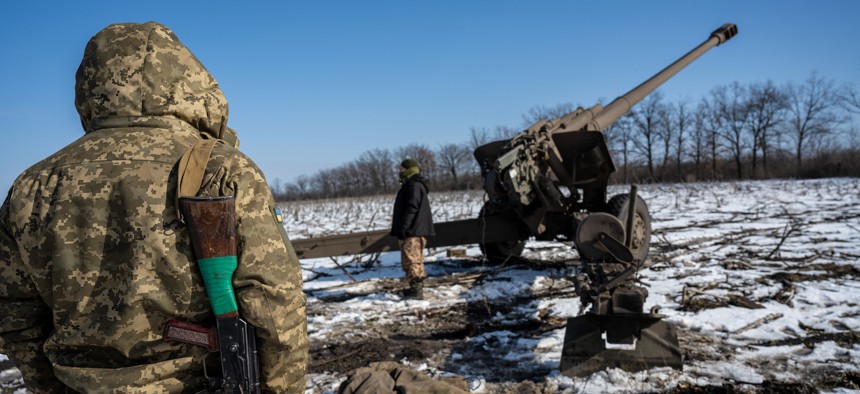
Armed with rifles to shoot down any incoming Russian drones, a Ukrainian artillery team races to set up their 152mm cannon in the southern Donbas region, Ukraine, on February 19, 2023. Scott Peterson / Getty Images
As Ukraine braces for winter drone attacks, allies rush to provide defenses
But some of the very latest U.S. systems are being held back—so far.
As Ukraine braces for a repeat of last winter’s drone strikes on its electrical networks, allied nations are sending Kyiv some—but not all—of their latest in anti-drone tech.
Last year, Russia targeted infrastructure in Ukrainian cities, blacking out cities amid a cold winter and causing worries that some cities might need to be evacuated if heating systems failed.
This year, Ukrainian air force spokesman Yuriy Ihnat warned that the winter would likely bring a “record” number of Russian drone attacks. Ihnat noted Russia’s Shahed 136, an Iranian-designed loitering munition capable of flying more than a thousand miles to strike targets.
Russian drones also wreak havoc on the battlefield. September, Polish Lt. Gen. Wieslaw Kukuła told Defense One that “most” of the Polish-donated howitzers damaged by Russia were hit by loitering munitions.
Many of the new anti-drone systems the U.S. and others are sending to Ukraine consist of some form of autocannon combined with a radar tracking system and an electronic warfare jammer. Such systems meet incoming drones first with jammer emissions meant to disrupt navigation and break their links back to their Russian controllers. Drones that survive are targeted by the autocannon’s explosive shells.
Loitering munitions are increasingly using inertial guidance systems on their final approach that make them harder to jam, according to Silie Jahr, head of sales at anti-drone company MARSS. MARSS operates across the Middle East, where drone attacks have targeted the U.S. and others.
Among the gun systems announced as either sent to Ukraine or soon to be so are the MSI-DS Terrahawk Paladin and EOS’s Slinger, both announced in early October, and Kongsberg’s CORTEX Typhon, announced in August.
A fourth gun system, Northrop Grumman’s Agnostic Gun Truck (AGT), will be sent to Ukraine “very shortly” after being first announced in April, the Army said in October. With the exception of MSI’s Paladin, the systems are mounted on vehicles, with the AGT and Slinger advertised as being mounted on pickup trucks.
“We’re finding great promise with 30mm” autocannon shells for destroying drones, said Mike Parent of the Army’s Joint Counter-small Unmanned Aircraft Systems Office.
Alongside the counter-drone gun truck, the Pentagon in April announced a truck mounting counter-drone missiles that would also be sent to Ukraine. SAIC was among the companies competing to send the truck, but it is unclear which company was ultimately chosen and if the system has been sent to Ukraine.
The systems will join a panoply of other companies sending anti-drone systems to Ukraine, including jammers from DroneShield, CEO Oleg Vornik told Defense One.
Such systems are effective against the many commercially bought drones that Russia uses, according to DroneShield’s US CEO Matt McCrann. In certain cases, jamming can even be effective against drones operating with jamming countermeasures, Vornik said.
“They can go silent, but then they often like to switch on the comms back to the controller, because they want to have a confirmed kill,” said Vornik. “At that point they become your usual two-way communication situation.”
Other systems include L3Harris’s Vampire missile system, and Fortem’s DroneHunter F700, a drone that fires a net to capture enemy drones.
Valery Zaluzhny, head of Ukraine’s armed forces, appeared to nod to the system in a recent article where he said net-throwing drones were a means of gaining air superiority.
The systems join a number of weapons capable of shooting down drones that the U.S. and others have donated from their own military stocks, including Germany’s Gepard and U.S.’s Avenger, the former of which Ukraine has said is effective against Shaheds.
What’s missing
Notably absent are some of the most advanced anti-drone systems being developed or purchased for U.S. troops.
On Wednesday, Epirus delivered the first prototype of a high-power microwave anti-drone weapon to U.S. soldiers as a part of a $66 million prototyping contract.
The system, dubbed the Indirect Fire Protection Capability – High-Power Microwave, is based on Epirus’s Leonidas system and is designed to defeat drone swarms like the ones increasingly used on Ukrainian battlefields.
The U.S. has also not sent a 50-kw drone-killing laser that the Army is testing for battlefield use, nor the Army’s short-range air defense system, the M-SHORAD, or the Marine equivalent, the L-MADIS.
While the Epirus system and lasers are prototypes, so are some of the systems being sent to Ukraine. Northrop Grumman’s AGT was an experimental product with no production line until the government’s award, said Rob Menti, a Northrop air defense portfolio manager.
Other weapons sent are new, if more recently out of prototyping stages. L3Harris’s Vampire began testing only in 2021, with a prototype being selected by the Pentagon for shipment to Ukraine in August 2022. MSI’s Terrahawk Paladin entered serial production in January, said product manager Robert Gordon at London arms show DSEI.
One factor may be that such gun and radar systems are more exportable — Northrop’s AGT, for example, is designed with export in mind.
“We couldn't design an exquisite system that we couldn't export, or that the customer would find unaffordable,” said Menti.
The more complex a system is, by contrast, the longer it takes to export, a State Department official previously told Defense One.
For gear like night vision or sensor systems, “There's definitely going to be policy considerations that have to have to be weighed there, and those could prolong the adjudication of those requests,” said Catherine Hamilton, who leads State’s Directorate of Defense Trade Controls.




